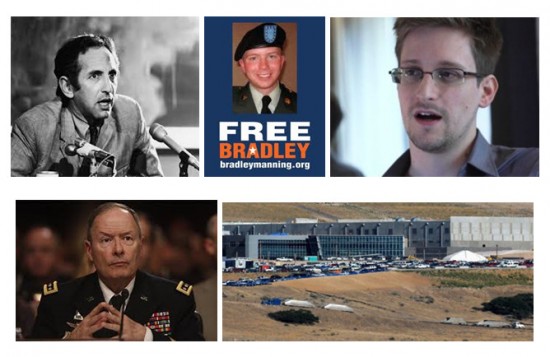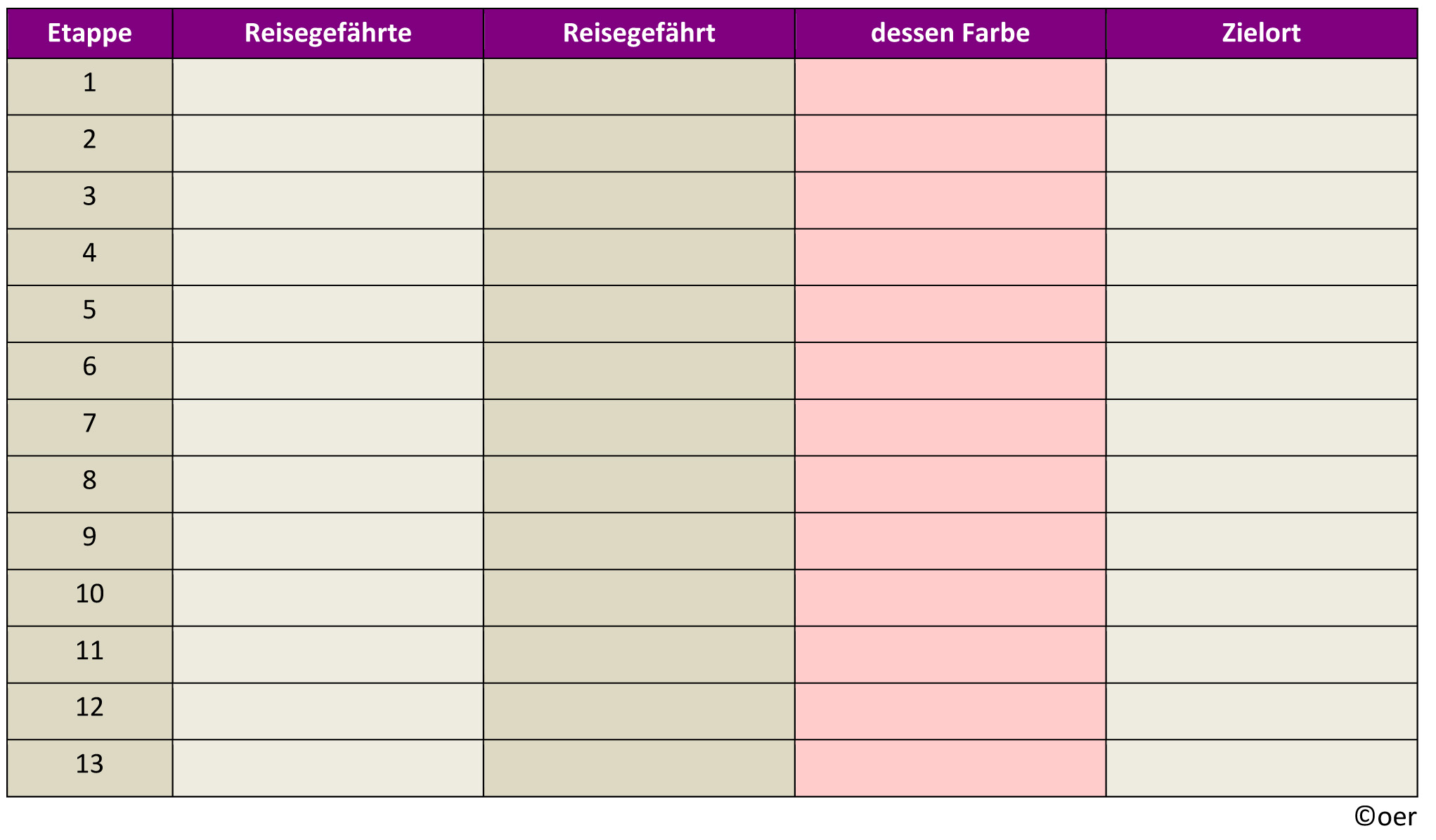LEAKERS & PROFITEERS (clockwise, from top left): Daniel Ellsberg, former military analyst, gave classified “Pentagon Papers” to the New York Times in 1971; Bradley Manning, imprisoned U.S. Army private, provided secret Iraq War documents to WikiLeaks in 2010; Edward J. Snowden, computer geek hiding in Hong Kong, provided National Security Agency documents for newspaper exposés this June; “Bumblehive,” code name for the N.S.A.’s gigantic “Utah Data Center,” opening in September; Keith Alexander, U.S. Army general and director of the N.S.A., aka “Dr. Strangelove.”
Annals of American Panic, Paranoia & Profiteering
By Thomas Adcock
Copyright © 2013 – Thomas Adcock
NEW YORK, near America
In 1941, the late Argentine writer Jorge Luis Borges published “The Library of Babel,” a satirical tale about reclusive monks engaged in esoteric studies in a secret warren of enormous rooms containing all the world’s knowledge in all the world’s languages. Overwhelmed by this vast agglomeration of facts, and the tedious labor of comparative philology, the monks find it ultimately impossible to understand much of anything.
Now in America, life imitates art in a parody of panic, paranoia, and profiteering.
As I write, seventy-two years after Señor Borges’ fiction, platoons of electricians are completing infrastructure for the disturbingly nonfiction “Utah Data Center,” latest enterprise of the hush-hush National Security Agency—an arm of the Pentagon. In September, the center becomes the mother ship of militarized cyberspace surveillance—a high technology spy grid that will create and cache digital dossiers on those Americans who use telephones and the internet. Meaning all of us.
General Keith Alexander of the U.S. Army and director of U.S. National Intelligence assures us that somewhere amongst the crumbs of quotidian babblings and scribblings—billions upon billions of crumbs—lie hot leads for the never-ending capital-B big business of thwarting terrorist mayhem. Unsurprisingly, General Alexander’s examples of successful implementation in this regard are few, overblown, and sometimes specious.
But never mind. In a few months, fresh posses of deputized computer hackers will do in Utah what is already done at satellite “listening posts.” A half-dozen such installations (that we know of) were established in the fevered aftermath of September 11, 2001—when suicidal al-Qaeda thugs hijacked jetliners and turned them into bombs that killed some three thousand innocents in New York and Washington.
On that awful morning, the roots of blind panic took hold throughout the land. They quickly flowered into a perennial angst about 9/11s to come. With the dawn of 9/12, it took a hot second for corporations, and the politicians they own, to realize that leveraged fear would yield bumper crops of hefty profits in years to come.
Thus was born a newfound private sector goldmine: lucrative military contracts, awarded in the cause of counterterrorism. Writing in the New York Times of June 18, author and defense expert Tim Shorrock counts seventy percent of the annual budget for U.S. intelligence operations—$80 billion, or €60 billion—now flowing to private companies. Which makes corporate counterterrorism a growth industry, with yearly revenues of $56 billion (€42 billion).
These billions finance the building of high-tech archipelagos of snoopery, and for the recruitment of young computer geeks and hackers into the ranks of modern-day spies. Americans like Edward J. Snowden, who has lately come in from the cold—minus the trench coat and fedora of yesteryear.
Monkishly hunched over keyboards, today’s spies pluck personal communications from the ether as entries into electronic files that bulge with kilobytes, megabytes, gigabytes, terabytes, petabytes, and exabytes of data. (Perhaps one day, though it is now but a gleam in the eye of some anonymous geek, N.S.A. dossiers will be measured in yottabytes.)
The purpose? Washington says it is secretly necessary to gather and store “metadata” of the citizenry—by which is meant, Who do we telephone? Who do we e-mail or Twitter or Facebook or Skype? Do we blog? What websites do we visit? When? Why? How often, and for how long?
Intrusive questions, to be sure. But we’re fighting terrorism, by god!
We have long assumed the Orwellian impulse of Washington. And now there are continuing reports that make our imaginings real—thanks to Mr. Snowden’s leaks to the Guardian newspaper of Britain, by way of the American lawyer and journalist Glenn Greenwald.
Due to his study of Mandarin—and his being on the lam, understandably, in Hong Kong—Mr. Snowden is branded by the usual howling pack of Congressional hicks and yahoos, abetted by media blowhards, as a Chinese spy who deserves a firing squad. Rhetoric of the professionally righteous aside, Mr. Snowden’s motivation—to make his countrymen aware of actual and potential military abuse of the constitutional right to privacy—is in the spirit of Americans who dare speak truth to the corruptible power of their own government. Two among this distinguished breed:
• As a Harvard-educated military analyst working at the RAND Corporation, Daniel Ellsberg leaked Defense Department communiqués to the New York Times in 1971—the so-called Pentagon Papers, revealing systematic lies relative to the Vietnam War, told to the public by the presidential administrations of John F. Kennedy and Lyndon B. Johnson. At the spirited insistence of then President Richard M. Nixon, Mr. Ellsberg was hauled before a Los Angeles federal court and indicted for crimes under the Espionage Act of 1917—which could have resulted in his imprisonment for one hundred and fifteen years. Charges were dismissed, however, when Judge William M. Byrne Jr. ruled that the Nixon administration’s “gross misconduct” in initiating criminal acts of harassment against Mr. Ellsberg had “incurably infected prosecution” and “offend[ed] a sense of justice.” Ultimately, Mr. Nixon himself was punished: he was forced to resign from office in 1973, the same year Mr. Ellsberg was cleared. Mr. Nixon died, in disgrace, in 1994. Mr. Ellsberg is today seen as a hero of American civil liberties.
• While stationed in Iraq in 2010, computer geek and U.S. Army Private Bradley Manning downloaded material from military databases. The material demonstrated a host of government lies and atrocities relative to the U.S. wars in Afghanistan and Iraq, embarrassing data passed along to Julian Assange’s
WikiLeaks operation. In turn, Mr. Assange enlisted the Guardian and the Times as newspaper venues. For nearly a year, Mr. Manning was held in solitary confinement at a Marine Corps brig, until transferred to Fort Leavenworth prison. His trial for “aiding the enemy” and eleven other counts of treason began early this month. Mr. Assange, meanwhile, is much wanted by U.S. authorities and lives in sanctuary at the Ecuadoran Embassy in London. Mr. Ellsberg, now 79 years old, has twice been arrested by federal marshals for his efforts to visit Private Manning. “I was that young man,” Mr. Ellsberg said in March, in an interview with CNN News. “I was willing to go to prison. I never thought I would ever hear anyone willing to do that—to risk their life so that horrible, awful secrets could be known.”
In both the Ellsberg and Manning cases, the yahoos and blowhards claimed calamitous damage to the national security. No calamity ever occurred, and not the slightest damage was or is evidenced.
We are told that it is crucial to the life and limb of the republic that the N.S.A. collect “metadata” as a precaution against traitors in our midst. And never mind the numerous failures of detection by the mightiest surveillance bureaucracy the world has ever seen: the N.S.A. failed to pick up communications in advance of the al-Qaeda bomb attack on New York, in 1993, as well as 9/11 itself; bombings of the U.S. embassies in East Africa in 1998; the suicide attack on the USS Cole in Yemen in October 2000; the attempted downing of a Paris-to-Detroit commercial flight by Richard “the shoe bomber” Reid in 2001; Faisal Shahzad’s plot to blow up Times Square with car bombs on May Day 2010; and the Tsarnaev brothers’ pipe bombs at the Boston Marathon last April.
Imagine all the telephone and internet chatter involved. Imagine reclusive monks in rooms full of kilobytes, megabytes, gigabytes, terabytes, petabytes, and exabytes. Imagine Señor Borges, looking down from Heaven in sorry amusement.
Media hullabaloo over terrorism and domestic spying—flash: the U.S. government is watching you!—provides cover for a more immediate, much more familiar threat: deadly gunfire, ranging from the periodic rampages of mass murderers to children killing other children whilst playing with loaded pistols lying here and there about the house.
The latest participants in the monotony of American gun mania were six persons mowed down in Santa Monica, California, on June 7—with a dozen more gravely wounded. The gunman was John Zawahri, the lunatic owner of a perfectly legal Bushmaster AR-15 semiautomatic rifle and 1,300 steel-piercing .223 caliber bullets—the very model of modified machine gun, and ammo, used last December to slaughter twenty-two schoolchildren and six teachers in Newtown, Connecticut.
Mr. Zawahri, 23, was himself shot and killed by police. The New York Times, famous for the masthead slogan “All the News That’s Fit to Print,” reported the episode in a few paragraphs that ran on Page 23 of its June 8 edition.
Had certain long-needed legislation been in force, inquiries as to Mr. Zawahri’s mental state might well have prevented his gun licensure. In fact, such legislation came before Congress in April—a bill requiring would-be gun buyers to affirm that they are not convicted felons, spouse beaters, or psychotics. The usual gang howled about government invasion of gun lovers’ privacy, and accordingly pleased the multi-billion dollar armaments industry by voting nay. The bill failed. The same gang, however, is gung-ho for the N.S.A.’s wholesale assault on privacy, in partnership with corporate America. Money talks—persuasively.
In the interest of risk assessment, it is useful to consider these numbers:
• A recent study of fatalities as the consequence of terror attacks on American soil was conducted by the federally-funded National Consortium for the Study of Terrorism and Responses to Terrorism. Excluding 9/11 casualties, fewer than five hundred people died in the U.S. from terrorism between 1970 and 2010. Adding the 9/11 figures brings a rounded toll of approximately 3,500 deaths over the span of forty years.
• The annual rate of gun deaths in America—one-on-one homicides as the largest subtotal, with mass murder growing exponentially with the booming sales of semiautomatic weaponry—is estimated at 30,000 by the U.S. Centers for Disease Control. Multiplied over the same forty-year, at the stunning rate of 30,000 corpses per annum, some 2,900,000 Americans were killed by guns between 1970 and today.
Small wonder that Mr. Snowden seeks safe harbor in Hong Kong, that Mr. Assange has sanctuary in an Ecuadoran embassy building—and that Mr. Greenwald lives in Brazil. In America, they could all be shot. It happens.
•
The incipient Utah Data Center is known among N.S.A. personnel as “Bumblehive,” a likely homage to Utah’s slogan as the “beehive state.” (Or perhaps some wag coined a snarky reference to N.S.A.’s bumbling, as cited herein.)
Located in the remote settlement of Bluffdale, in ultra-devout Mormon territory, the center is situated about a mile from the nation’s largest polygamous commune—the Apostolic United Brethren (and sister-wives, presumably). Writing in the March 15, 2012 edition of Wired magazine, University of California Professor James Bamford described Bumblehive as the “largest, most covert, and potentially most intrusive intelligence agency ever” in world history.
At one million square feet (9,290,304 square metres), the Utah facility has five times more floor space than the U.S. Capitol building in Washington. According to Mr. Bamford, a U.S. Navy intelligence officer during the Vietnam War, construction costs to date total $2 billion (€1.5 billion), with estimated annual electrical generation costs for its immense computers and servers of $40 million (€30.1 million).
Hundreds of new employees will be needed for snooping—perhaps thousands. Where to find hirable geeks?
Last July, in anticipation of staffing needs at Bumblehive, General Alexander traveled to Las Vegas as keynote speaker for “Def Con 2012,” a gathering of up-and-coming computer hackers. The general doffed his four-star dress uniform for the occasion, opting instead for a T-shirt stiffly tucked into blue jeans. Def Con attendees referred to him as “Dr. Strangelove.”
“In this room, this room right here, is the talent our nation needs to secure cyberspace,” the general told his audience. “We don’t pay as high as everybody else (sic), but we’re fun to be around.”
He added, cryptically, “We’re innovating democracy.”
Thomas Adcock
Thomas Adcock is American correspondent for CulturMag.














